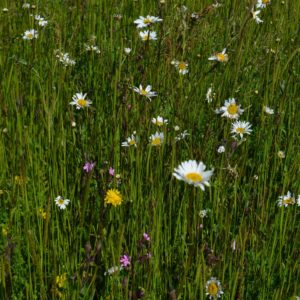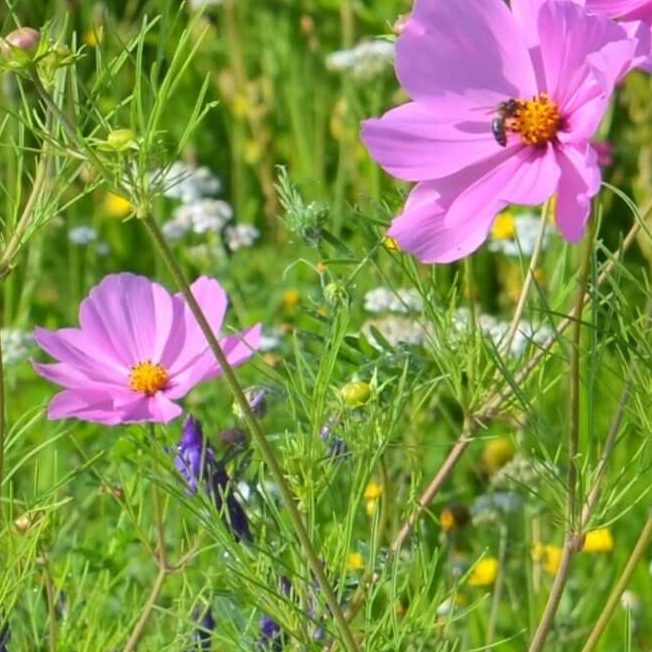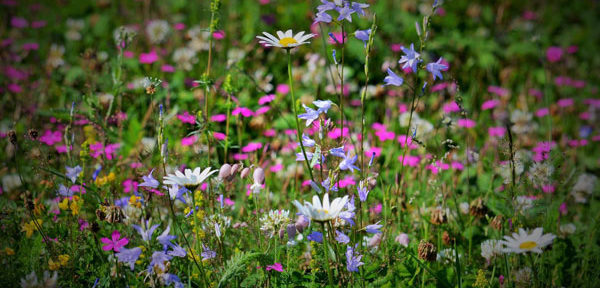Planting wildflowers on a slope – It’s a real joy to see wildflowers growing on a bank or a hillside. There’s a height and a depth to the planting that you don’t see anywhere else and it brings all those lovely blooms and butterflies right up to eye level. But how do you create that effect on an area that may not be very easy to cultivate?
Meadowmat Wildflower turf is a convenient and easy way to establish wild flowers on to a slope. As it’s pre-grown, it will put down roots very quickly that will help stabilise the soil. But you must be sure that the slope you want to carpet with native species really is a suitable place for them to grow. It’s that old adage “right plant, right place”
How do I know if my slope is suitable for wildflowers?
Not every slope or bank will grow wild flowers successfully. As a rough guide, here is a 5 point checklist to help you decide whether or not to invest in Meadowmat Wildflower Turf for your project.
- Does the site get sunshine for at least half the day?
If the slope is in a shady place, eg by a wood, the wildflowers and grasses that grow in Meadowmat will probably struggle to thrive. They are sun worshippers that like moist, but free-draining soil. - How steep is the slope?
As a rule of thumb, if the angle of the slope is more than about 45 degrees, it’s probably too steep to a site to successfully install, establish and maintain wildflower turf. - How deep is the soil layer?We recommend that Meadowmat is laid onto at least 15cm depth of prepared soil. Some banks have been eroded and have very little soil on them. So, if that is the case for your slope, you will need to import some low nutrient topsoil if your wildflowers are to have any chance of survival.
- How rich is the soil?
This question applies wherever you are thinking of growing wildflowers. Our native plants have evolved to grow in impoverished soil and some species just cannot cope with rich garden soil. It is well worth investing in, and using, an NPK soil testing kit before ordering your Meadowmat. If the Phosphorus level is higher than 20mg/litre, it’s a good idea to bring in some low nutrient topsoil to help solve the problem. But, where soil nutrient levels are too rich for wild flowers, grasses will romp away and swamp the more delicate species leaving you with a limited floral palette. - Will you be able to install, establish and maintain your wildflowers safely?
Please remember Meadowmat wild flower mats are quite heavy. So, it’s a two person job to lift and manoeuvre them into place. Realistically, can you work safely on the slope you have? Remember too that the mats will need watering daily for at least 2-3 weeks. Also, when the mats have established, the vegetation will need to be cut back and removed at least once a year. How will you do that?
Products that can help…
 |
 |
 |
 |
How to lay a wildflower mat on a sloping surface
Once you are sure that Meadowmat is a practical groundcover product for your slope, you need to prepare the ground.
- Firstly, remove every last piece of vegetation, leaves, shoots, roots, everything. That way you’re less likely to get problems with invasive weeds.
- Then, loosen the soil to a depth of 15cm. If you can’t dig down that far, then loosen the soil as deep as you can and top it up with low nutrient growing medium. Don’t skimp on the preparation at this stage – the plants need to get their roots well into your soil or they won’t survive.
- Measure the area carefully and order your Meadowmat. For most places in the UK, Meadowmat can be delivered 3 working days from the date we receive your order. Be sure to arrange delivery so that you’ll be able to install the mats on the day they arrive. Meadowmat is perishable, it shouldn’t be left rolled up for more than 24 hours.
- Press the soil down firmly and then rake it. I know you’ve just loosened it but if it’s too loose it will wash down the slope when you water your Meadowmat. You’re trying to achieve something that has a similar texture to the topping on a proper apple crumble (not one that I’ve baked, my apple crumble is more like a paving slab than a planting bed).
- When your wildflower turf arrives, start laying the rolls in place. Pressing each one down so that it has good contact with the soil beneath. Butt the rolls up closely together and try to avoid walking on newly laid Meadowmat. On a slope greater than about 10 degrees, it’s worth using tent-pegs to hold the matting in place while the roots settle in. After all, you wouldn’t want the whole lot to slip down to the bottom.
- Water it well. You should be able to gently lift one corner and see that the soil is soaking wet beneath the matting.
- Finally, water thoroughly at least once a day for the first fortnight. On steep slopes, it is advisable to water in the morning and in the evening for the first few days, just to counteract the effects of runoff. After that, gradually reduce the amount and the frequency of watering until the plants are quite self sufficient.
When will my Meadowmat flower?

At first, your Meadowmat will seem as though it isn’t growing at all. Don’t worry, there’ll be a lot of activity going on underground. The plants are busy putting their roots down into your soil. Once the roots are well established and happy – and providing it’s the right time of year – the leaves will start growing.
If your Meadowmat was planted before the end of March, you will have a beautiful floral display in the first summer
For Meadowmat installed in April, May or June you will have some flowers in the first summer but nowhere near as many as you will have next year. Autumn installations give the best floral display in their first year – but you have to wait 8 or 9 months to see it.
How to care for Meadowmat on a slope
Meadowmat wildflower turf is incredibly easy to look after and you’ll find that if it has enough sunshine and deep enough impoverished soil it will bring you great deal of pleasure for a very small amount of work.
Meadowmat maintenance tips
- Never ever ever add any soil improver, compost or fertiliser of any kind.
- If there is more grass than you hoped for and not enough flowers, sow yellow rattle seeds in the autumn
- If you are using Traditional Meadowmat, cut the vegetation down to a height of 10cm once it has finished flowering. Usually around mid-late summer. Remove all cuttings.
- If you are using Meadowmat for Birds and Bees, leave the vegetation in place until after Christmas. That way you and the birds will benefit from the seed heads. When you do cut it back, it needs to be around 10cm high and all cuttings must be taken away.
Sounds simple? that’s because it is.
Questions about growing wildflowers on a slope
I hope this blogpost has been helpful but I’m sure you still have some questions to ask…..
You may also be interested in….

 Growing wildflowers on a slope
Growing wildflowers on a slope  15 Wildflowers Beloved By Bees
15 Wildflowers Beloved By Bees 

